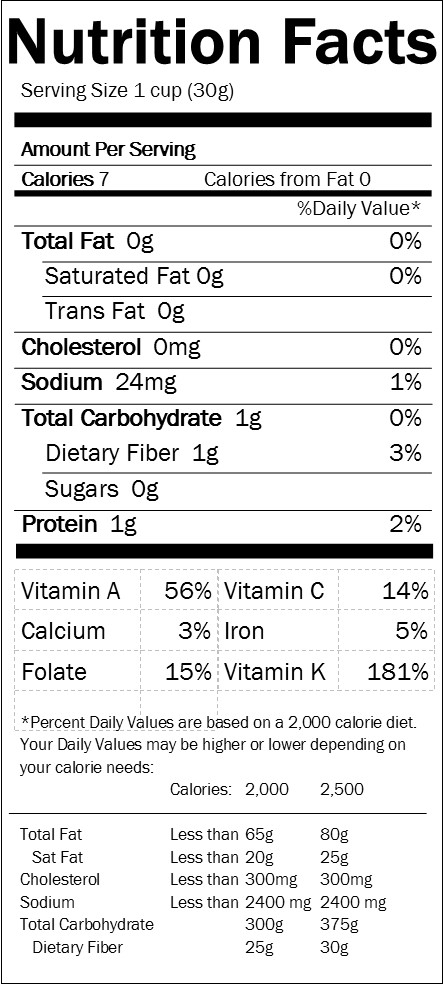
SELECTION
Look for dark or bright green leaves (not yellowed) without damage or blemishes. Leaves should look fresh without any wilting. In general, the smaller the leaves, the more mild the flavor. Baby spinach are young, smaller leaves that are more tender and sweeter with more tender stems – these are better for salads and using raw while the larger more mature leaves are better suited to quick cooking.
STORAGE
Store spinach unwashed in a plastic bag in the vegetable bin of the refrigerator. It will last 3-5 days for best quality but can be used until it shows signs of decay (yellowing, slime).
PREPARATION
Wash spinach well to remove any sandy grit by immersing in a large bowl full of cold water and swishing so that the grit falls to the bottom and then gently lift spinach off the top. Don’t let it soak though as it will wilt and leach nutrients. Remove any yellowed or wilted leaves. Dry well by using a salad spinner or wringing in a towel. If using mature spinach, remove any large or woody stems. If cooking spinach, it will take quite a bit raw to yield a decent amount cooked – in general, 1 pound raw = 6-9 cups torn = 1 cup cooked or about 1/2-3/4 cup pressed dry.
EDIBLE PARTS
Leaves and tender stems.
HOW TO TRY
Spinach can be eaten raw or cooked.
Spinach salads offer a wonderful array of flavors and combinations. Spinach pairs well with fruits like strawberries, oranges, cranberries (dried), cherries and apples. Start with a fruit, add some nuts and a cheese like blue or goat with a vinaigrette dressing for a special salad. Spinach salads also are popular with warm dressings to lightly wilt the spinach. Try heating a balsamic vinaigrette.
Eggs and spinach are a classic combination. Try adding thawed frozen spinach or cooked and drained fresh spinach to your favorite quiche, omelet or frittata. Spinach soufflés are another egg choice.
Spinach stuffings can be used in mushrooms, hollowed out tomatoes, rolled up in a butterflied pork loin or stuffed into pockets in chicken breasts and then baked.
Lasagna is a great choice for added spinach. Try a chicken lasagna with an Alfredo sauce, spinach, mushrooms and Cheddar cheese.
Instead of lettuce on your next sandwich, try adding spinach for extra flavor and nutrition.
Make a dip for vegetables, crackers or chips by combining thawed frozen spinach or cooked and drained fresh spinach to half sour cream/half mayonnaise with dried soup mix (onion, leek or vegetable).
Spinach wilts down quickly and is best if cooked just until lightly wilted.
VARIETIES
Spinach comes in savoy (curly or crinkled), flat leaf, semi savoy and baby. The savoy tends to collect more grit in the crevices so be sure to wash well. It is more full flavored while the flat leaf is easier to clean and more mild in flavor. Semi savoy has the texture like savoy but is easier to clean because of the way it grows. Baby is usually the less mature version of flat leaf and is more tender and sweet.


Preservation
Cooking Techniques
- Raw
- Boiling
- Steaming
- Braising
- Sautéing
- Stir Frying
Flavor Pairings
- Cheese (esp. Parmesan, Swiss, Cheddar, Blue, Goat)
- Vinegar
- Eggs
- Nutmeg
- Fruits (esp. citrus)
- Garlic
- Pork (bacon, ham, etc.)
- Tomatoes
Recipes
- Spinach Stuffed Mushrooms
- Sally’s Spinach Salad
- Spinach Salad with Warm Bacon Vinaigrette
- Spinach and Cherry Salad with Warm Bacon Vinaigrette
- Spinach and Beet Salad
- Spring Spinach Salad with Lemon Vinaigrette
- Spinach Salad with White Beans
- Strawberry Spinach Salad
- Sweet Potato Orange Winter Salad
- Winter Apple Salad with Pomegranate Vinaigrette
- Spinach Rolls
- Spinach Tart
- Grilled Fish Over Spinach with Lemon Ginger Sauce
- Green Eggs and Ham in Puff Pastry
- Roast Beef Spinach Wraps